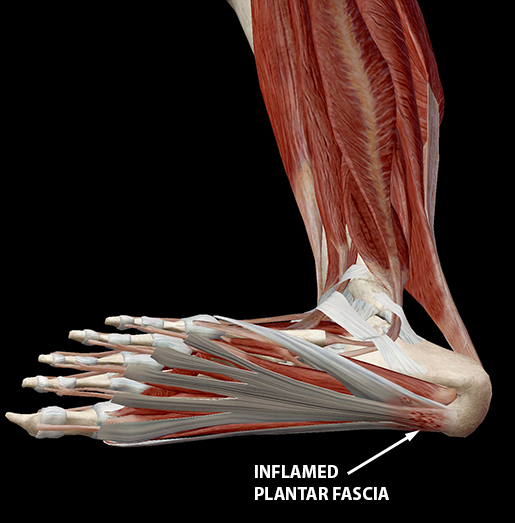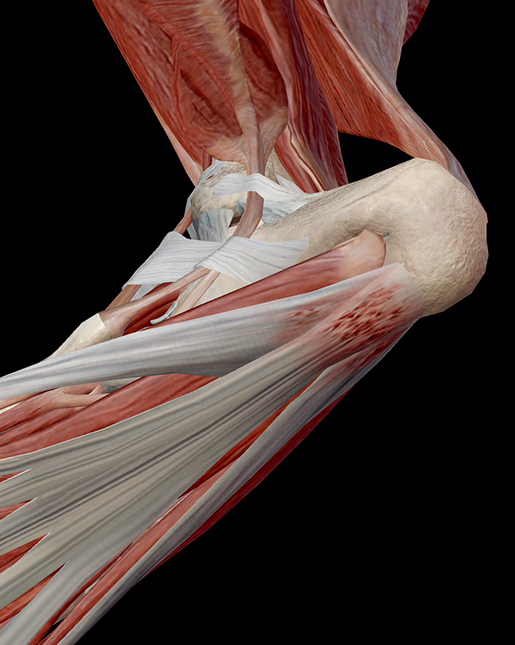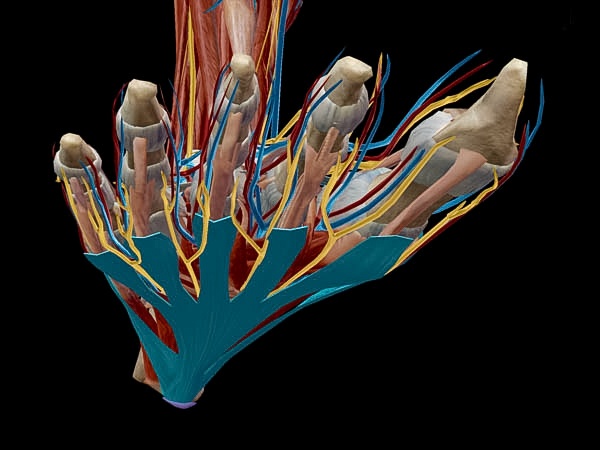Run With This: Anatomy, Physiology, and Pathology of Plantar Fasciitis
Posted on 6/30/17 by Marian Siljeholm
A few months ago I took up running, which, if you don’t know me, might not sound all that exciting. If you do, it might sound like the first sign of the apocalypse. But don’t stock up on bottled water just yet, because two weeks into my newfound fitness I found myself waking up in pain, specifically on my right heel. After a few days of ignoring it, desperation finally led me to my doctor, who took one look at my swollen heel and sent me straight to the podiatrist; I had plantar fasciitis.

Image from Muscle Premium.
One very expensive new pair of sneakers later I wondered, where did this pain come from? To figure this out, we first have to talk anatomy. Supporting the arch along the bottom (plantar) side of the foot between the heel bone (calcaneus, to be precise) and toes stretches a thick band of connective tissue called the plantar fascia. Not to be confused with heel spurs, a different injury with similar symptoms, plantar fasciitis occurs when the plantar fascia becomes irritated and sore. Since the plantar fascia supports your foot, providing a tension bridge as well as shock absorption, it gets used every time you take a step. However, it can only take so much; with too much pressure, the plantar fascia fibers can become damaged, to which the body responds by causing inflammation in the affected area, causing pain and stiffness.
While most common in runners, dancers, and athletes in sports that involve a lot of running or jumping, you don’t have to be an athlete to get plantar fasciitis (clearly). People who are pregnant, overweight, or have to stand for frequent extended periods and don’t wear proper, supportive footwear also have a higher likelihood of developing plantar fasciitis.
But how can we avoid this? Become couch potatoes? While I’m tempted to take that course of action, it turns out “being active” isn’t purely to blame. Shucks. Let’s first examine some of the culprits.
- Tight calf muscles. In addition to making it harder to flex your foot, tight calves put more stress on the plantar fascia.
- Weight. Don’t kill the messenger, but a few extra pounds on the skeletal structure adds pressure on your feet with each step.
- Certain sports and activities (especially after periods of inactivity) (whoops), such as running, hiking, dancing, and aerobics, puts excess pressure on your feet.
- Bad shoes. This, according to the overly fit looking saleswoman who sold me my overpriced new sneakers, was my problem. It turns out she wasn’t wrong, but she was awfully condescending. Footwear that doesn’t give your foot adequate support increases your risk of plantar fasciitis. You’ll want to ditch any shoes that have thin soles or inadequate arch support, or ones that don’t fit your feet properly. Ditching the high heels can also help, as routinely wearing high heels can cause your Achilles tendon to contract over time, making it harder to flex your foot.
- A lot of standing or walking on hard surfaces. Jobs that keep you on your feet all day, like waiting tables or working in a store, can harm your plantar fascia, especially without adequately supportive footwear.
- High arches, flat feet, or other chronic and untreated foot problems. The shape of your foot affects the way your weight is distributed on your feet. If weight distribution is off, this can increase a person’s risk of plantar fasciitis.
Now let’s talk symptoms. When does plain foot pain turn plantar?
The most obvious symptom of plantar fasciitis is a sharp pain on the bottom of the foot, near the heel. Perhaps counterintuitively, the pain is strongest first thing in the morning but actually diminishes after some walking. The relief is often short lived, however, as in this condition pain develops gradually and becomes worse over time, especially after long periods of standing or intense activity. Pressure and stretching will increase the pain, despite the latter playing a role in solving the problem.
 A closeup of microtears on the plantar fascia. Image from Muscle Premium.
A closeup of microtears on the plantar fascia. Image from Muscle Premium.
So, you’ve woken up from a wild night of dancing in excruciating pain. Or, like me, you’ve woken up from enough nights of pain to finally do something about it. What are your options?
Let’s start with the good news. Despite how crippling the pain might be when you first wake up, plantar fasciitis usually goes away after a few months if you do not do as I did and ignore it. Simple things like stretching exercises and cutting back on activities that might have caused the problem are first steps that go a long way. In terms of the immediate pain relief I desperately sought, I learned that rest was the first step (not that I was in any condition for anything else) and that over-the-counter pain medicines can also help; however, for those who dislike taking pills as much as I do, ice or a cold compress can also be very beneficial in reducing pain and inflammation. Shoe inserts, taping of the affected area by a trainer, and night splints to keep your calf muscles gently flexed and stop the plantar fascia from tightening overnight can also be beneficial. If the pain doesn’t abate over a few months your doctor might recommend stronger medications, steroid injections (eeep, needles), or even surgery.
The best course of action, really, is taking preventive measures. Ok, mom, thanks for stating the obvious. But truly, for this condition in particular a little bit of prevention goes a very long way. You can start by wearing supportive shoes that fit properly, especially if you know that your job involves standing or being on your feet. Also, especially for the athletes out there, when your shoes start to run down, get a new pair! Staying in shape also carries huge weight here (no pun intended), since by keeping your weight in check you’ll also reduce the amount of stress on your feet. Another especially important one for athletes (or those of us who dabble): stretching! Implementing a few stretches focused on your calves and feet before you exercise will diminish your risk of developing plantar fasciitis. When stretching isn’t sufficient, talk to your doctor about getting heel pads, custom shoe inserts, or orthotics, as such additional foot support, especially for those with high arches or flat feet, can provide cushioning and ensure even weight distribution, decreasing strain on key points in your feet.
Finally, the one closest to my heart: when starting a new activity or exercise, take it slow. Learn from my mistakes, people: exercise is great, but going for broke might backfire if it means you’re too injured to keep up the good work over the long run. Instead of running ten miles the first time, start with a light jog and build up from there. Rome wasn’t built in a day but it was taken down in one. Just saying.
 Image from Muscle Premium.
Image from Muscle Premium.
Ironically, regular activity (in moderation), once you’re healed and feel able, coupled with stretching is the most efficient way to keep this pesky painful condition at bay by keeping your muscles accustomed to the exertion. Apologies for just trashing your excuse for staying on the couch. But hey, there are always things to be gained from pain, and I’ve even managed to make a new friend out of my experience, and no his name is neither Ben nor Jerry, but tennis ball. It turns out, rolling a tennis ball under your foot (and under your back if you get as many knots there as I do) actually provides an amazing massage experience in addition to helping heal plantar fasciitis. Talk about killing two conditions with one ball. Score.
Be sure to subscribe to the Visible Body Blog for more anatomy awesomeness!
Are you a professor (or know someone who is)? We have awesome visuals and resources for your anatomy and physiology course!
Learn more here.
Additional Sources:
"Plantar Fasciitis." KidsHealth. Ed. Suken A. Shah. The Nemours Foundation, Nov. 2014. Web. 29 June 2017.




